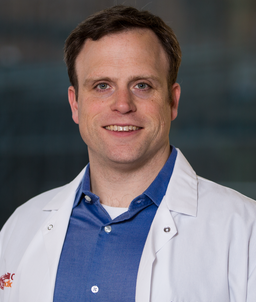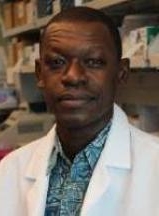Physicians and scientists at Weill Cornell Medicine and NewYork-Presbyterian have rapidly mobilized to confront the COVID-19 pandemic, focusing a broad spectrum of expertise on the critical issues the disease is posing to healthcare workers and public health officials.
As COVID-19 spreads across the United States, state and county governments require new tools to track the disease, and physicians urgently need effective treatments for their patients. While social distancing required rapidly ramping down most other research activity, investigators in infectious disease and a range of other specialties have swiftly changed gears to meet the new challenge.
With numerous studies underway in both the translational and clinical arenas, we are dividing our coverage of COVID-19 research into multiple stories. Below is a snapshot of some of the activities going on in the basic and translational research community.
Tracking the Outbreak

Dr. Olivier Elemento
One of the keys to preventing the spread of any infectious disease and preparing for outbreaks is knowing where hotspots are emerging. In the absence of very large-scale testing, researchers are looking for other clues that the virus is present in a community. To rapidly acquire that information, Dr. Olivier Elemento, director of the Caryl and Israel Englander Institute for Precision Medicine and a professor of physiology and biophysics at Weill Cornell Medicine, and his collaborators are asking people to participate in a daily online survey in which they submit symptoms as well as information such as travel patterns and known exposures to infected individuals. The team is also gathering state public health data to determine if the survey information is predictive of the reported COVID-19 cases. “The hope is that we can identify which counties are poised for potential outbreaks earlier,” said Dr. Elemento.
To preserve anonymity, the survey only requires the first three digits of the person’s zip code, and the data are analyzed and reported on a HIPAA-compliant website available to all. As interest in this approach has grown, the Weill Cornell Medicine team has partnered with a nationwide consortium called the How We Feel Project to expand the disease-tracking capabilities even further.
Diagnosing the Disease

Dr. Christopher Mason
While experts in data analysis craft a portrait of the disease landscape, Dr. Christopher Mason, an associate professor of physiology and biophysics and co-director of the WorldQuant Initiative for Quantitative Prediction at Weill Cornell Medicine, is developing a diagnostic test that is designed to complement most currently used methods. Based on a method called loop-mediated isothermal amplification, or LAMP, the test looks for evidence of the virus in samples collected from a swab of the inner cheek. Using a simple set of chemicals, it makes millions of copies of a portion of the virus’s genetic material, which can then be easily detected by a color change. In contrast to polymerase chain reaction (PCR)-based tests, which require sophisticated machinery that cycles between high and low temperatures, the entire LAMP test can be performed at a single temperature with simple equipment.
“People can be asymptomatic for about five days, and yet they'll be carrying tens of thousands of copies of the virus, or millions of copies, in their mouth,” said Dr. Mason, who is also an associate professor of computational genomics in computational biomedicine in the HRH Prince Alwaleed Bin Talal Bin Abdulaziz Al-Saud Institute for Computational Biomedicine at Weill Cornell Medicine. “We need a way to increase testing capacity to include asymptomatic potential carriers. The test needs to be fast, cheap and performed entirely at the site of administration. We currently have capacity to test only symptomatic patients and healthcare workers, so this method is a potential way to scale up.”
The diagnostic may soon be submitted to the FDA for emergency use approval.
“If we perfect these methods and make them cheap enough, they’re going to be part of a broader surveillance, like a viral weather map,” Dr. Mason said.
Finding Drugs to Fight the Virus

Dr. Robert Schwartz
Doctors on the front lines of caring for COVID-19 patients have very limited tools to fight the disease. So scientists are mobilizing to find drugs that stop coronavirus infection.
Most virus research is conducted with monkey cells, and while these cells are useful for studying how the virus replicates, they may poorly mirror human cells and their response to infection. To address that problem, Weill Cornell Medicine investigators have teamed up to create a more realistic drug screening platform.

Dr. Shuibing Chen
Drs. Robert Schwartz, assistant professor of medicine in the Division of Gastroenterology and Hepatology at Weill Cornell and a hepatologist at NewYork-Presbyterian/Weill Cornell Medical Center, and Shuibing Chen, associate professor of chemical biology in surgery, screened through many different tissue types to see which cells are infected by the virus.
They found that the lung, colon, pancreas and liver tissue are easily infected. With their chosen testing material in hand, they worked with Dr. Todd Evans, who is associate dean for research and the Peter I. Pressman, M.D. Professor in Surgery at Weill Cornell Medicine, to test many drugs simultaneously.

Dr. Todd Evans
“For our first drug screening test, we used colon tissues infected with an inactivated viral particle to screen 1,200 FDA-approved drugs,” said Dr. Chen, who is also the Kilts Family Associate Professor of Surgery. The team found several drugs that blocked the viral particle from entering the cell and teamed up with collaborators at Icahn School of Medicine at Mount Sinai for the next step--verifying that the drugs block infection by the active coronavirus.
“Now we’ve identified three drugs that have robust inhibition not just of the virus entering the cell, but also of the virus replicating,” said Dr. Schwartz. “Since the drugs we find using this platform are already approved by the FDA for use in patients, it may be relatively easy to repurpose them for clinical trials with COVID-19 patients,” noted Dr. Evans.
Research Community Forms COVID-19 Research Alliance Guide Ongoing and Future Efforts

Dr. Douglas Nixon
Researchers across Weill Cornell Medicine are communicating on a daily basis to share their expertise and assess the best ideas to pursue in their labs. What began as a grassroots effort among clinicians and scientists is coalescing into a research alliance facilitated by Weill Cornell Medicine’s Office of Research and Office of Clinical Research.

Dr. Lishomwa Ndhlovu
Two HIV researchers, Dr. Douglas Nixon, professor of immunology in medicine, and Dr. Lishomwa Ndhlovu, newly recruited as professor of immunology in medicine, initially spearheaded efforts to set up a communication channel for everyone interested in COVID-19-related basic and translational research in March. “It was inspiring to see the individual commitment of researchers across the institution actively sharing insight and updates through this channel and bridging new links to address the complex challenges of the pandemic,” said Dr. Ndhlovu. The investigators also enlisted the help of graduate students to organize and curate the content. “There’s been an enormous outpouring of people wanting to help in the Weill Cornell research community,” Dr. Nixon said.

Dr. Hugh Hemmings
“It has been very uplifting to see how many Weill Cornell Medicine scientists have wanted to contribute to fighting this disease,” said Dr. Hugh Hemmings, senior associate dean for research at Weill Cornell Medicine. “They have applied their diverse skills to developing new approaches to treating and diagnosing coronavirus, and to positioning us to prevent or to be able to respond more effectively to pandemics like this one.”
Clinicians, as will be described in a related story, initiated dozens of investigations encompassing numerous aspects of clinical research, from clinical trials to analyses of medical records to help predict which patients may rapidly decline.

Dr. Rainu Kaushal
“COVID-19 has been an unprecedented epidemic both in terms of its scale and the need to develop new assays and new therapies rapidly to treat this virus,” said Dr. Rainu Kaushal, senior associate dean for clinical research at Weill Cornell Medicine. “I have been so impressed by the multidisciplinary collaborations among clinical leadership and clinical researchers at Weill Cornell Medicine, which has led to hundreds of proposals regarding treatment, prevention and testing assays.”
Now, to create an infrastructure in support of new COVID-19 projects, the Weill Cornell Medicine administration is setting up three research committees focused on interventional studies, collecting and curating observational biospecimens, and data analysis. Once the immediate crisis passes, the institution plans to continue research to better prepare healthcare and public health workers for new outbreaks.
“We're thinking about the future, we're positioning ourselves to strike as soon as we can open up our labs and get going at full speed again,” Dr. Hemmings said. “That's been very exciting and that's what is keeping our scientists going.”

